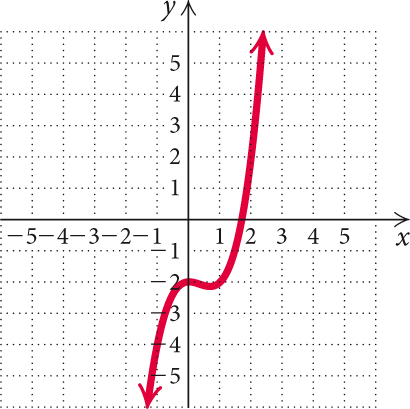 Chapter Test
by Marvin L. Bittinger, Judith A. Penna, Judith A. Beecher
Algebra and Trigonometry, 5th Edition
Chapter Test
by Marvin L. Bittinger, Judith A. Penna, Judith A. Beecher
Algebra and Trigonometry, 5th Edition
- Algebra & Trigonometry
- Contents
- Preface
- Get the most out of MyMathLab®
- Resources for Success
- To the Student
- Chapter 1 Graphs, Functions, and Models
- 1.1 Introduction to Graphing
- 1.2 Functions and Graphs
- 1.3 Linear Functions, Slope, and Applications
- Visualizing the Graph
- 1.3 Exercise Set
- Mid-Chapter Mixed Review
- 1.4 Equations of Lines and Modeling
- 1.4 Exercise Set
- 1.5 Linear Equations, Functions, Zeros, and Applications
- 1.5 Exercise Set
- 1.6 Solving Linear Inequalities
- 1.6 Exercise Set
- Chapter 1 Summary and Review
- Chapter 2 More on Functions
- 2.1 Increasing, Decreasing, and Piecewise Functions; Applications
- 2.2 The Algebra of Functions
- 2.3 The Composition of Functions
- 2.4 Symmetry
- 2.4 Exercise Set
- 2.5 Transformations
- 2.6 Variation and Applications
- Chapter 2 Summary and Review
- Chapter 3 Quadratic Functions and Equations; Inequalities
- 3.1 The Complex Numbers
- 3.2 Quadratic Equations, Functions, Zeros, and Models
- 3.3 Analyzing Graphs of Quadratic Functions
- Mid-Chapter Mixed Review
- 3.4 Solving Rational Equations and Radical Equations
- 3.5 Solving Equations and Inequalities with Absolute Value
- Chapter 3 Summary and Review
- 3 Chapter Test
- Chapter 4 Polynomial Functions and Rational Functions
- 4.1 Polynomial Functions and Models
- 4.2 Graphing Polynomial Functions
- 4.3 Polynomial Division; The Remainder Theorem and the Factor Theorem
- Mid-Chapter Mixed Review
- 4.4 Theorems about Zeros of Polynomial Functions
- 4.5 Rational Functions
- 4.6 Polynomial Inequalities and Rational Inequalities
- Chapter 4 Summary and Review
- Review Exercises
- Chapter Test
- Chapter 5 Exponential Functions and Logarithmic Functions
- 5.1 Inverse Functions
- Inverses and One-to-One Functions
- Finding Formulas for Inverses
- Inverse Functions and Composition
- Restricting a Domain
- 5.2 Exponential Functions and Graphs
- Graphing Exponential Functions
- Applications
- The Number e
- Graphs of Exponential Functions, Base e
- 5.3 Logarithmic Functions and Graphs
- Logarithmic Functions
- Example 1
- Finding Certain Logarithms
- Converting Between Exponential Equations and Logarithmic Equations
- Finding Logarithms on a Calculator
- Natural Logarithms
- Changing Logarithmic Bases
- Graphs of Logarithmic Functions
- Applications
- Example 12
- Example 13
- Visualizing the Graph
- 5.3 Exercise Set
- Skill Maintenance
- Synthesis
- Mid-Chapter Mixed Review
- 5.4 Properties of Logarithmic Functions
- 5.5 Solving Exponential Equations and Logarithmic Equations
- 5.6 Applications and Models: Growth and Decay; Compound Interest
- Chapter 5 Summary and Review
- Chapter Test
- Chapter 6 The Trigonometric Functions
- 6.1 Trigonometric Functions of Acute Angles
- 6.2 Applications of Right Triangles
- Applications
- Bearing: First-Type
- 6.3 Trigonometric Functions of Any Angle
- Mid-Chapter Mixed Review
- 6.4 Radians, Arc Length, and Angular Speed
- 6.5 Circular Functions: Graphs and Properties
- Graphs of the Sine and Cosine Functions
- Graphs of the Tangent, Cotangent, Cosecant, and Secant Functions
- 6.6 Graphs of Transformed Sine and Cosine Functions
- Chapter 6 Summary and Review
- Study Guide
- Review Exercises
- Synthesis
- Collaborative Discussion and Writing
- 6 Chapter Test
- Synthesis
- Chapter 7 Trigonometric Identities, Inverse Functions, and Equations
- 7.1 Identities: Pythagorean and Sum and Difference
- 7.2 Identities: Cofunction, Double-Angle, and Half-Angle
- 7.3 Proving Trigonometric Identities
- Mid-Chapter Mixed Review
- 7.4 Inverses of the Trigonometric Functions
- 7.5 Solving Trigonometric Equations
- Chapter 7 Summary and Review
- Review Exercises
- 7 Chapter Test
- Chapter 8 Applications of Trigonometry
- 8.1 The Law of Sines
- 8.2 The Law of Cosines
- 8.3 Complex Numbers: Trigonometric Notation
- 8.4 Polar Coordinates and Graphs
- 8.5 Vectors and Applications
- 8.6 Vector Operations
- Chapter 8 Summary and Review Study Guide
- Review Exercises
- Chapter Test
- Chapter 9 Systems of Equations and Matrices
- 9.1 Systems of Equations in Two Variables
- 9.2 Systems of Equations in Three Variables
- 9.3 Matrices and Systems of Equations
- 9.4 Matrix Operations
- 9.5 Inverses of Matrices
- 9.6 Determinants and Cramer’s RuleDeterminants and Cramer’s Rule
- 9.7 Systems of Inequalities and Linear Programming
- 9.8 Partial Fractions
- Chapter 6 Summary and Review
- Chapter 10 Analytic Geometry Topics
- 10.1 The Parabola
- 10.2 The Circle and the Ellipse
- 10.3 The Hyperbola
- 10.4 Nonlinear Systems of Equations and Inequalities
- Nonlinear Systems of Equations
- Modeling and Problem Solving
- Nonlinear Systems of Inequalities
- Visualizing the Graph
- 10.4 Exercise Set
- 10.5 Rotation of Axes
- 10.6 Polar Equations of Conics
- 10.7 Parametric Equations
- Chapter 10 Summary and Review Study Guide
- Review Exercises
- Chapter 11 Sequences, Series, and Combinatorics
- 11.1 Sequences and Series
- 11.2 Arithmetic Sequences and Series
- 11.3 Geometric Sequences and Series
- 11.4 Mathematical Induction
- 11.5 Combinatorics: Permutations
- 11.6 Combinatorics: Combinations
- 11.7 The Binomial Theorem
- 11.8 Probability
- Chapter 11 Summary and Review
- Just-In-Time Review
- Real Numbers
- Properties of Real Numbers
- Absolute Value
- Operations with Real Numbers
- Order on the Number Line
- Interval Notation
- Integers as Exponents
- Scientific Notation
- Order of Operations
- Introduction to Polynomials
- Add and Subtract Polynomials
- Multiply Polynomials
- Factor Polynomials
- Equation-Solving Principles
- Inequality-Solving Principles
- Principle of Zero Products
- Principle of Square Roots
- Simplify Rational Expressions
- Multiply and Divide Rational Expressions
- Add and Subtract Rational Expressions
- Simplify Complex Rational Expressions
- Simplify Radical Expressions
- Rationalizing Denominators
- Rational Exponents
- Pythagorean Theorem
- Answers
- Visualizing the Graph
- Exercise Set 1.1
- Exercise Set 1.2
- Visualizing the Graph
- Exercise Set 1.3
- Mid-Chapter Mixed Review: Chapter 1
- Exercise Set 1.4
- Exercise Set 1.5
- Exercise Set 1.6
- Review Exercises: Chapter 1
- Test: Chapter 1
- Exercise Set 2.1
- Exercise Set 2.2
- Exercise Set 2.3
- Mid-Chapter Mixed Review: Chapter 2
- Exercise Set 2.4
- Visualizing the Graph
- Exercise Set 2.5
- Exercise Set 2.6
- Review Exercises: Chapter 2
- Test: Chapter 2
- Exercise Set 3.1
- Exercise Set 3.2
- Visualizing the Graph
- Exercise Set 3.3
- Mid-Chapter Mixed Review: Chapter 3
- Exercise Set 3.4
- Exercise Set 3.5
- Review Exercises: Chapter 3
- Test: Chapter 3
- Exercise Set 4.1
- Visualizing the Graph
- Exercise Set 4.2
- Exercise Set 4.3
- Mid-Chapter Mixed Review: Chapter 4
- Exercise Set 4.4
- Visualizing the Graph
- Exercise Set 4.5
- Exercise Set 4.6
- Review Exercises: Chapter 4
- Test: Chapter 4
- Exercise Set 5.1
- Exercise Set 5.2
- Visualizing the Graph
- Exercise Set 5.3
- Mid-Chapter Mixed Review: Chapter 5
- Exercise Set 5.4
- Exercise Set 5.5
- Exercise Set 5.6
- Review Exercises: Chapter 5
- Test: Chapter 5
- Exercise Set 6.1
- Exercise Set 6.2
- Exercise Set 6.3
- Mid-Chapter Mixed Review: Chapter 6
- Exercise Set 6.4
- Exercise Set 6.5
- Visualizing the Graph
- Exercise Set 6.6
- ReviewExercises: Chapter 6
- Test: Chapter 6
- Exercise Set 7.1
- Exercise Set 7.2
- Exercise Set 7.3
- Mid-Chapter Mixed Review: Chapter 7
- Exercise Set 7.4
- Visualizing the Graph
- Exercise Set 7.5
- Review Exercises: Chapter 7
- Test: Chapter 7
- Exercise Set 8.1
- Exercise Set 8.2
- Exercise Set 8.3
- Mid-Chapter Mixed Review: Chapter 8
- Visualizing the Graph
- Exercise Set 8.4
- Exercise Set 8.5
- Exercise Set 8.6
- Review Exercises: Chapter 8
- Test: Chapter 8
- Visualizing the Graph
- Exercise Set 9.1
- Exercise Set 9.2
- Exercise Set 9.3
- Exercise Set 9.4
- Mid-Chapter Mixed Review: Chapter 9
- Exercise Set 9.5
- Exercise Set 9.6
- Exercise Set 9.7
- Exercise Set 9.8
- Review Exercises: Chapter 9
- Test: Chapter 9
- Exercise Set 10.1
- Exercise Set 10.2
- Exercise Set 10.3
- Visualizing the Graph
- Exercise Set 10.4
- Mid-Chapter Mixed Review: Chapter 10
- Exercise Set 10.5
- Exercise Set 10.6
- Exercise Set 10.7
- Review Exercises: Chapter 10
- Test: Chapter 10
- Exercise Set 11.1
- Exercise Set 11.2
- Visualizing the Graph
- Exercise Set 11.3
- Exercise Set 11.4
- Mid-Chapter Mixed Review: Chapter 11
- Exercise Set 11.5
- Exercise Set 11.6
- Exercise Set 11.7
- Exercise Set 11.8
- Review Exercises: Chapter 11
- Test: Chapter 11
- Just-In-Time
- Photo Credits
- Index of Applications
- Agriculture
- Astronomy
- Automotive
- Biology/Life Sciences
- Business
- Chemistry
- Construction
- Consumer
- Economics
- Education
- Engineering
- Environment
- Finance
- General Interest
- Geometry
- Government
- Health/Medicine
- Labor
- Physics
- Social Sciences
- Sports/Entertainment
- Statistics/Demographics
- Technology
- Transportation
- Index
- Review Exercises
- Study Guide
- Logarithmic Functions
Chapter Test
Determine the leading term, the leading coefficient, and the degree of the polynomial. Then classify the polynomial as constant, linear, quadratic, cubic, or quartic.
1.
f(x)=2x3+6x2−x4+11 2.
h(x)=−4.7x+29 3. Find the zeros of the polynomial function and state the multiplicity of each:
f(x)=x(3x−5)(x−3)2(x+1)3. 4. Hybrid Automobiles. In 2004, only 84,199 hybrid automobiles were sold, while in 2012, 431,798 were sold (Source: U.S. Department of Transportation). The quartic function
f(x)=897.690x4−10,349.487x3+ 19,202.137x2+91,597.838x+ 88,209.580, where x is the number of years after 2004, can be used to estimate the number of hybrid automobiles sold in years 2004 to 2012. Use this function to estimate the number of hybrid automobiles sold in 2008 and in 2011.
Sketch the graph of the polynomial function.
5.
f(x)=x3−5x2+2x+8 6.
f(x)=−2x4+x3+11x2−4x−12
Using the intermediate value theorem, determine, if possible, whether the function has a zero between a and b.
7.
f(x)=−5x2+3; a=0, b=2 8.
g(x)=2x3+6x2−3; a=−2, b=−1 9. Use long division to find the quotient
Q(x) and the remainderR(x) whenP(x) is divided byd(x) . ExpressP(x) in the formd(x)⋅Q(x)+R(x) . Show your work.P(x)d(x)==x4+3x3+2x−5,x−1 10. Use synthetic division to find the quotient and the remainder. Show your work.
(3x3−12x+7)÷(x−5) 11. Use synthetic division to find
P(−3) forP(x)=2x3−6x2+x−4 . Show your work.12. Use synthetic division to determine whether −2 is a zero of
f(x)=x3+4x2+x−6 . Answer yes or no. Show your work.13. Find a polynomial function of degree 4 with −3 as a zero of multiplicity 2 and 0 and 6 as zeros of multiplicity 1.
14. Suppose that a polynomial function of degree 5 with rational coefficients has 1,
3–√ , and2−i as zeros. Find the other zeros.
Find a polynomial function of lowest degree with rational coefficients and the following as some of its zeros.
15.
−10, 3i 16.
0, −3–√, 1−i
List all possible rational zeros.
17.
f(x)=2x3+x2−2x+12 18.
h(x)=10x4−x3+2x−5
For each polynomial function, (a) find the rational zeros and then the other zeros; that is, solve
19.
f(x)=x3+x2−5x−5 20.
f(x)=2x4−11x3+16x2−x−6 21.
f(x)=x3+4x2+4x+16 22.
f(x)=3x4−11x3+15x2−9x+2 23. What does Descartes’ rule of signs tell you about the number of positive real zeros and the number of negative real zeros of the following function?
g(x)=−x8+2x6−4x3−1
Graph the function. Be sure to label all the asymptotes. List the domain and the x- and y-intercepts.
24.
f(x)=2(x−3)2 25.
f(x)=x+3x2−3x−4 26. Find a rational function that has vertical asymptotes
x=−1 andx=2 and x-intercept (−4, 0).
Solve.
27.
2x2>5x+3 28.
x+1x−4≤3 29. The function
S(t)=−16t2+64t+192 gives the height S, in feet, of a model rocket launched with a velocity of64 ft/sec from a hill that is 192 ft high.30. The graph of
f(x)=x 3−x 2−2 is which of the following?
Synthesis
31. Find the domain of
f(x)=x2+x−12−−−−−−−−−√ .
-
No Comment



